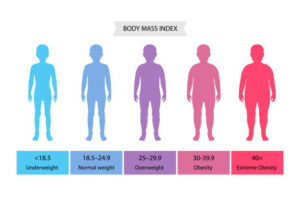With our BMI calculator for guys, you can find out what your BMI is, as well as what a healthy BMI for men is and where you fall on the BMI chart for men. Furthermore, you may get more accurate information on what constitutes a normal BMI using this BMI calculator for men. We also offer tools and advice on how to enhance your place in the male BMI ranges.
What is BMI?
Let’s begin with the fundamentals, shall we? Body Mass Index (BMI) is a one-dimensional metric for determining body type/category. You can fall into one of three groups based on your BMI: underweight, normal, or overweight. There are more subcategories, but these three are the most significant.
If you’ve come to this page, you’re most likely looking for an answer to the question, “What is my BMI?” You can use the calculator on the left of this text to do so, or you can calculate it yourself using the BMI formula below:
BMI = weight / height²
It is important to pay attention to the units since BMI is measured in kg/m².
As you can see, BMI is quite easy to calculate, which is both its greatest strength and its worst weakness. Because it only considers height and weight, it ignores a vast number of elements that influence a person’s body composition, such as lean body mass, body fat, and body water %. These are crucial to the proper functioning of our bodies.
We welcome you to use our waist-to-height ratio calculator and body type calculator to get all the information you need. Alternatively, we have various calculators accessible to you, such as the army body fat calculator and the navy body fat calculator, both of which will provide you with additional health-related data.
Why do we need a BMI calculator for male?
We know that the BMI calculation does not take gender into account, so why do we need a BMI calculator for men? Adults and children/adolescents have varied anthropomorphic traits, and males and women have diverse physical characteristics even among adults. This implies we shouldn’t anticipate the healthy BMI for men to be the same as the healthy BMI for women, nor should we expect the BMI charts for men and women to be the same as the BMI ranges for men and women.
In general, we could compare men and women and not be too far off the mark, but for more precision, we’ve opted to divide our BMI calculators into four primary population groups: children, teens, men, and women.
World Health Organization and BMI categories
There are nearly endless alternatives for putting up distinct BMI ranges for men, which is one of the reasons why there are multiple recognized ways to group normal BMI for guys. The instructions offered by the World Health Organization (WHO) on page 9 of their study Obesity: Preventing and Managing the Global Epidemic will be used for the remainder of the article. The WHO divides and categorizes guys into three broad BMI groups (as previously stated: underweight, normal/healthy, and overweight).
Each of the categories, however, may be further differentiated to distinguish between mild overweight and hyper-obesity on the one hand, and slightly underweight and severely undernourished on the other.
BMI range for men and what the percentiles mean
When discussing BMI (or any other statistical metric), we frequently use the term percentiles. Percentiles are usually stated as an ordinal number, which complicates things. To put it another way, percentiles provide a rapid method to compare one person to the entire population. To further comprehend it, consider the steps you should take if you wanted to construct your own percentile for any statistic.
To begin, you’ll need to collect data for all of the people in your population group, which for this calculator means collecting data on men’s BMI. The data should then be divided into 100 groups based on their BMI values, with each group having an identical BMI value.
You may now categorize any individual in their percentile by simply assigning him to the appropriate categories based on his BMI. His percentile would be determined by his group’s rank (from lowest to highest BMI). For example, he is in the 25th percentile if he is in the 25th group with the lowest BMI. This indicates he has a greater BMI than 25% of the population.
It’s worth noting that while the percentiles have a set number of persons in each category, the BMI values are not uniformly spread.
Last but not least, we should mention that percentiles are typically grouped together for practical reasons to prevent having too many categories. This means that percentiles are usually grouped in groups of at least five. This implies that you’re far more likely to hear about a surge from the 25th to the 50th percentile, or from the 5th to the 10th percentile, with no mention of percentiles in between.
In the broad scale of things, any accuracy lost in the process of lowering from 100 percentiles to 10 groupings of 5-percentiles size is inconsequential.
In our BMI calculator for males, for example, we’ve divided the percentiles into nine categories: 0th-5th, 5th-10th, 10th-15th, 15th-25th, 25th-50th, 50th-75th, 75th-85th, 85th-90th, 90th-95th. With the calculator’s output displaying the group’s highest percentile.
Healthy BMI prime and normal BMI
The so-called BMI prime is another metric you should be aware of. BMI Prime is a developed statistic that compares your BMI as a man to the normal or healthy BMI for men. BMI Prime is also accessible for other demographics, but as this is a BMI calculator for men, we’ll stick to that.
There’s no biological reason why one BMI is healthy while another isn’t; it’s entirely based on statistics. But all is not lost, because BMI’s statistical origins ensure that it will have some accuracy for large groups, if not for individuals.
WHO recognizes the limitations of BMI as the only instrument for determining what is optimal body weight and, as a result, suggests a more in-depth investigation for a more accurate diagnosis. BMI is only accurate for sedentary people, not for particularly active populations, growing youngsters, or the elderly, according to the WHO.
When it comes to professional athletes, one of BMI’s most glaring flaws in its application. Most elite athletes are “technically” overweight or obese according to BMI because they have a high percentage of fat-free mass (muscle has a higher density than body fat). So keep in mind that BMI isn’t the be-all and end-all of healthy body weight, and it only has a restricted range of applications.
BMI Prime is a number that is calculated by comparing your current BMI to the normal or healthy BMI, which is below 25. You may calculate your BMI prime by multiplying your BMI by 25 (a healthy BMI for males).
If we are part of the sedentary male population, our BMI prime will be a figure that is preferably very near to one, as it is the ideal number we should strive for. An underweight person has a BMI prime of less than one, whereas an overweight person has a BMI prime greater than one. There are healthy weight margins in the BMI prime, just like there are in the real BMI, so don’t fret if you’re sedentary and have a BMI prime of 0.98; you’re doing well!
What is my BMI or how to use the BMI calculator for men
Now that we’ve learned everything there is to know about BMI for men, BMI percentiles, and BMI ranges for men, it’s time to see how we can use the BMI calculator for men to bring it all together. Finally, you’ll be able to answer the age-old question, “What is my BMI?” To calculate your BMI, BMI prime, and percentile based on BMI and age, follow these steps:
- Enter your weight in your preferred mass units,
- Enter your height in your desired length units,
- At this point, you’ll get your calculated BMI as well as your BMI prime together with your WHO-category according to these numbers,
- Input your age in years if you want to know your percentile,
- The result will appear showing your percentile compared to the USA population in your age bracket.
Just keep in mind that this is a BMI calculator for males; if you’re searching for a calculator for another population group, click here. BMI calculators for men, women, children, and teens are available at Omni, with links in the second part of this calculator.


